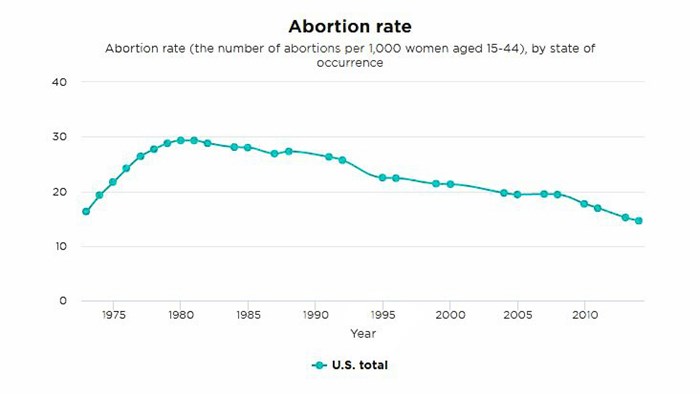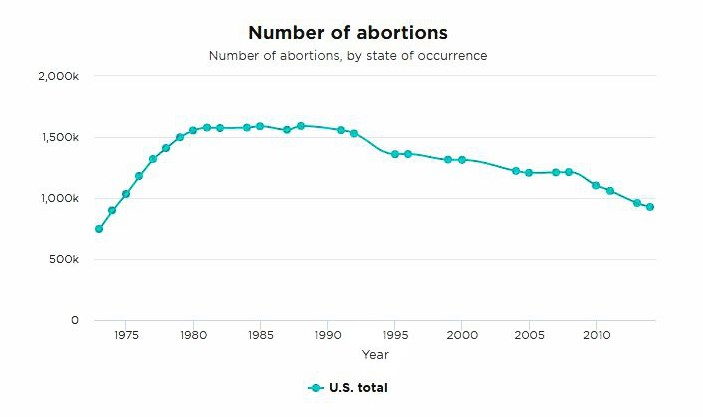
The abortion rate in the United States declined to an all-time low, while the number of lethal procedures dropped below a million for the first time since 1975, according to a new report.
The Guttmacher Institute reported Tuesday (Jan. 17) the rate fell to 14.6 abortions per 1,000 women 15 to 44 years old in 2014, which is a decline of 14 percent since its most recent survey in 2011.
In its census of all known abortion providers in the country, Guttmacher found abortions totaled 958,700 in 2013 and 926,190 in 2014.
The abortion rate reached its zenith at 29.3 in 1980 and 1981, and the total number of abortions peaked at more than 1.6 million in 1990, according to Guttmacher.

Pro-life advocates welcomed the report, and pointed to the work of pro-life citizens and legislators as a reason for the dramatic decline in abortions and their rate.
"The falling abortion number is due to the ceaseless advocacy and ministry of the pro-life community in neighborhoods all around this country," said Russell Moore, president of the Southern Baptist Ethics & Religious Liberty Commission (ERLC). "The pro-life movement advances by calling out to consciences with the truth of what unborn human life is and matching that call with real ministry to women in crisis.
"While a lower rate is undoubtedly good news, the violent taking of the life of even one unborn child ought to cause us to weep and redouble our efforts to protect every human life and contend against the predatory abortion industry," Moore told Baptist Press in written comments.
Americans United for Life (AUL), the country's leader in helping state legislators pass pro-life laws, cited such policies, as well as technology, in explaining the trend.
"Research has shown that life-affirming laws do have an impact on lowering the number of abortions, and with all the life-affirming laws passed since 2010, we have a reason to celebrate the number of lives saved and women protected as legislators worked to defend them from a predatory and rarely accountable abortion industry," AUL Acting President Clark Forsythe said in a written statement.
"But another factor in lower[ing] the number of abortions is the power of beautiful pictures of life inside the womb, through ultrasound," he said. "Such pictures are worth more than a thousand words when it comes to helping people understand whose lives are on the line."
In 2016, 43 states considered more than 360 abortion-related measures, according to AUL's annual report released Jan 10. The bills introduced included such measures as bans on government funding of abortion, restrictions on late-term abortions, ultrasound requirements, and prohibitions on abortions based on sex, race, or genetic abnormality.
The Guttmacher Institute, which is affiliated with the abortion rights movement, suggested the improved use of contraceptives attributed to the falling rate and total. But it also acknowledged state regulations and the declining number of abortion clinics may have contributed.
"Abortion restrictions and clinic closures mean that patients may need to travel greater distances to access services," said Rachel Jones, lead author of the study, in a written release. "The majority of abortion patients—75%—are poor or low-income, and nearly two-thirds are already parents. It can be very difficult for them to arrange for time off from work, transportation and child care. While many find ways to access care despite these obstacles, some of the abortion rate decline is likely attributable to women who were prevented from accessing needed services."
The good news for pro-lifers came only five days before the anniversary of Roe v. Wade—the Supreme Court's Jan. 22, 1973, decision that legalized abortion nationwide—and the observance of Sanctity of Human Life Sunday on the Southern Baptist Convention calendar.
It also arrived shortly before the second annual Evangelicals for Life conference Jan 26-28 in Washington, D.C. The conference—cohosted by the ERLC and Focus on the Family—features more than 50 speakers addressing not only abortion but such issues as adoption, end-of-life care, ministry to those with special needs, human trafficking, service to immigrants and refugees, and the development of a pro-life worldview. Conference attendees will be able to participate in the Jan. 27 March for Life.
The Guttmacher report also included the following information:
- Nearly half—45 percent—of all abortions in the first nine weeks of gestation were performed using pills, and the percentage of such nonhospital abortions increased from 24 percent in 2011 to 31 percent in 2014.
- The abortion rate declined between 2011 and 2014 in all but six states and the District of Columbia.
- Ninety percent of all U.S. counties in 2014 contained no abortion clinic.
- Five states—Mississippi, Missouri, North Dakota, South Dakota, and Wyoming—had only one abortion clinic apiece in 2014.
- The number of abortion clinics fell by 17 percent from 2011 to 2014.
- Abortion clinics made up 16 percent of all abortion facilities in 2014 but provided 59 percent of all abortions.
The Guttmacher Institute acknowledged its report has limitations. For instance, it reported only 58 percent of facilities it believes provided abortions in 2014 responded to the survey. Guttmacher used state health department information for 20 percent of facilities and made estimates on another 17 percent.
While the Guttmacher report is based partly on estimates, it covers all 50 states. The federal Centers for Disease Control and Prevention (CDC), which also reported a decline in abortions in its December announcement, does not require states to provide information on abortions. Three states—California, Maryland and New Hampshire—did not provide data to the CDC.
Forsythe said the country needs "a more complete picture of the impact of abortion on women, through verifiable tracking."
In its annual report, AUL named these as the 10 best states for protecting life in 2016: (1) Oklahoma; (2) Kansas; (3) Louisiana; (4) Arkansas; (5) Arizona; (6) South Dakota; (7) Mississippi; (8) Georgia; (9) Michigan; (10) Pennsylvania.
The 10 least protective states were: (1) Washington, for the eighth straight year; (2) California; (3) Vermont; (4) New Jersey; (5) Oregon; (6) Nevada; (7) New York; (8) Connecticut; (9) Massachusetts; (10) Hawaii.
The ERLC has offered six pro-life priorities for action by President-elect Trump and Congress in 2017, including the nomination and confirmation of a pro-life successor to the late Supreme Court justice Antonin Scalia, a permanent ban on all federal funding of abortion and the defunding of Planned Parenthood, the country's No. 1 abortion provider.

Support Our Work
Subscribe to CT for less than $4.25/month


















